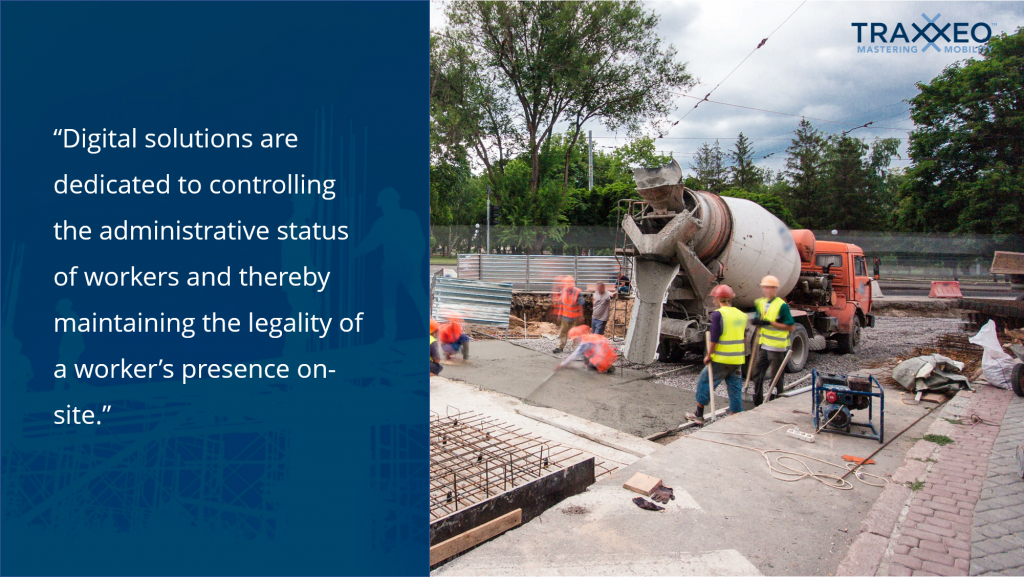
Construction is one of the sectors most affected by illegal employment practices. The impacts of this on a company are far reaching and can result in hefty financial penalties, not to mention damage to reputation.
Detecting and preventing illegal work on-site and off-site can be difficult, but this aspect of resource management is vital and can be made significantly easier by using the right software. This is just one example of the benefits of using software to improve the control of construction projects.
What is illegal work?
In this context, illegal work refers to workers on-site not having the correct permits and authorisations to carry out the job. This covers not only relevant labour laws (e.g. work permits, ID) but also mandatory skills and training (e.g. health and safety, working at height).
Ensuring the correct administrative order of workers is essential for managing construction site security and safety. For example, accidents can be prevented by ensuring that workers are adhering to their safety training and they are qualified to do the job in question.
How does illegal work impact on construction companies?
Due to increased political focus on the problem, construction companies are now being given even greater employment responsibilities as new regulations emerge in many countries to counter this phenomenon. For example, since Salvary’s law came into force in France (2014), construction contractors and project owners are now jointly liable for infringements committed on their sites by subcontractors.
As a consequence, controls are getting ever more onerous on companies: in Belgium, any construction company with a project budget greater than €500k must now provide a daily report on the presence of its workers on-site, through the Checkinatwork service. Fines for breaching laws are also going up. For example, fines for guilty workers can be hundreds of euros but for companies, it can be much, much more.
The reputational damage that occurs either from an accident arising on-site due to procedures not being followed, for example, or from being dragged through the courts for breaching regulations can also be significant and long lasting.
So, it is clear that the substantial legal risks and economic consequences of illegal work are increasing for construction companies.
Difficulties encountered when tackling illegal and undeclared work
Despite its obvious importance, detecting and avoiding the illegal presence of workers on-site is not always easy. It can be a tedious and time-consuming task, which consequently reduces the productivity of workers.
More specifically, it can be a time-consuming task on-site for the foreman and site manager. They might experience difficulties in accessing the current administrative status of workers and therefore will struggle to determine whether someone is entitled to be on that site, doing a particular task. But it is the site foreman/manager’s responsibility if the worker’s presence is illegal.
Plus, it doesn’t stop there. Back at the office or headquarters, administrative staff can also encounter complications when fighting illegal work. Managing a large volume of paperwork from several sites can be problematic, especially when it is of mixed content and quality (or when it has been raining onto the paperwork!).
So, it can be hard to get an informed overview of the status of workers, which impacts the ability to spot anomalies in a timely manner and proactively communicate these to the site to prevent further problems.

Subcontracting and illegal work
Subcontracting is a very common practice in the construction sector. It offers many advantages to construction companies, such as a great flexibility in terms of workforce.
However, it is not without risks. It can make the fight against illegal labor even more difficult.
The main reason is a lack of compliance monitoring. This is because it leads to even less monitoring and control of the subcontractor’s workers and their administrative status. The result is even more risky, as there is less direct control but greater liability in case of illegality.
There are many ways digital technology can help for better management of construction subcontractors. Among them, ensuring workers compliance is an effective way to counter illegal work.
Construction software : ensure workers’ compliance at all time
Although illegal work sometimes occurs in sectors like construction, it does not have to be terminal because solutions are currently available.
On-site
For workers on-site, it means:
- A full overview of workers’ attendance trough a presence control mobile application, with access to their information about:
– Global administrative status (work permit, etc)
– Training status (health and safety, etc)
– Skills, etc. - Automatic alerts if someone is not correctly authorised and therefore they will also not be able to access the worksite, thanks to a flexible access control system.
- Site foreman/manager can indicate the actions taken (control, site exit, safety training, etc).
- Access codes can be created and shared throughout the worksite.
At the headquarters
For administrative managers of the general contractors, it allows you to:
- Efficiently manage the data of the workforce (and their employer) who attend the building site, within a global document management platform.
- Have a complete and accurate view of the administrative status and site training of your workers, temps and subcontractors.
- Use automatic recognition and validation systems to facilitate document management.
- Collect documents from your subcontractors in a structured and optimal way, based on employee profiles, regulations and your own internal rules.
- Manage the administrative statuses and site access authorisations.
Subcontracting
For subcontractors, it means:
- Sharing documents in a structured and optimal way, based on employee profiles, regulations and your own internal rules for the client.
- Automatic reminders in the case of missing documents or due dates.
- Automatic document sharing.
Towards better compliance supervision in the construction industry
The problem of illegal work in construction is significant and one that has major repercussions for a company, in terms of financial penalties and damage to reputation. However, ensuring optimal compliance at all time is almost an impossible task without the right tools.
An increased focus on it by legislators across the world means that it makes sound economic sense to tackle the problem sooner rather than later. Countering illegal work in the construction sector can be difficult, but the use of the right digital software can certainly make the task of compliance monitoring much easier.
From stronger access control management to efficient attendance tracking and better document management, digital technology has a major role to play in this area.
Ensure your workers and subcontractors’ compliance at all time with Traxxeo